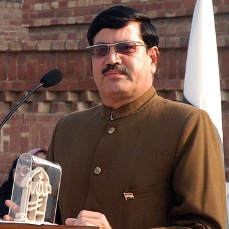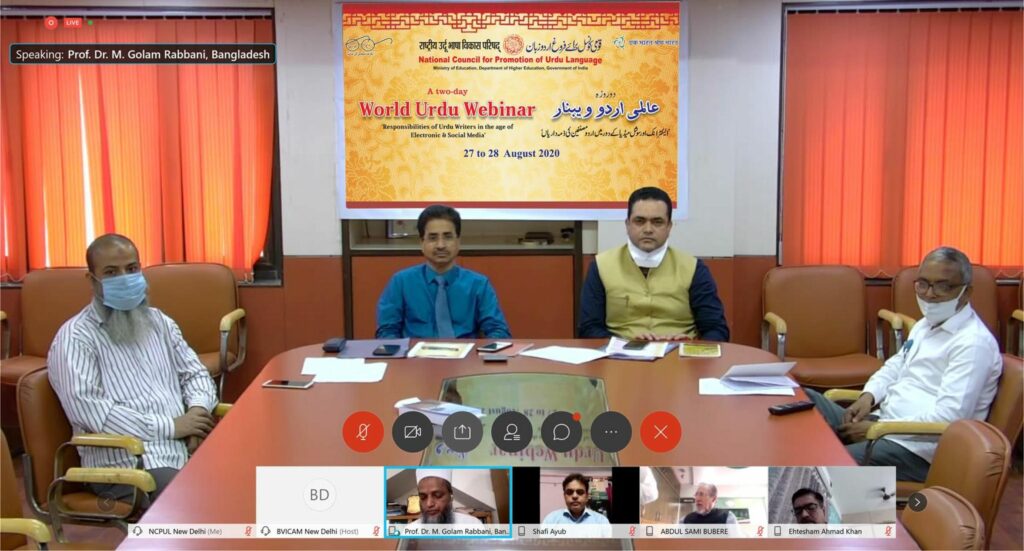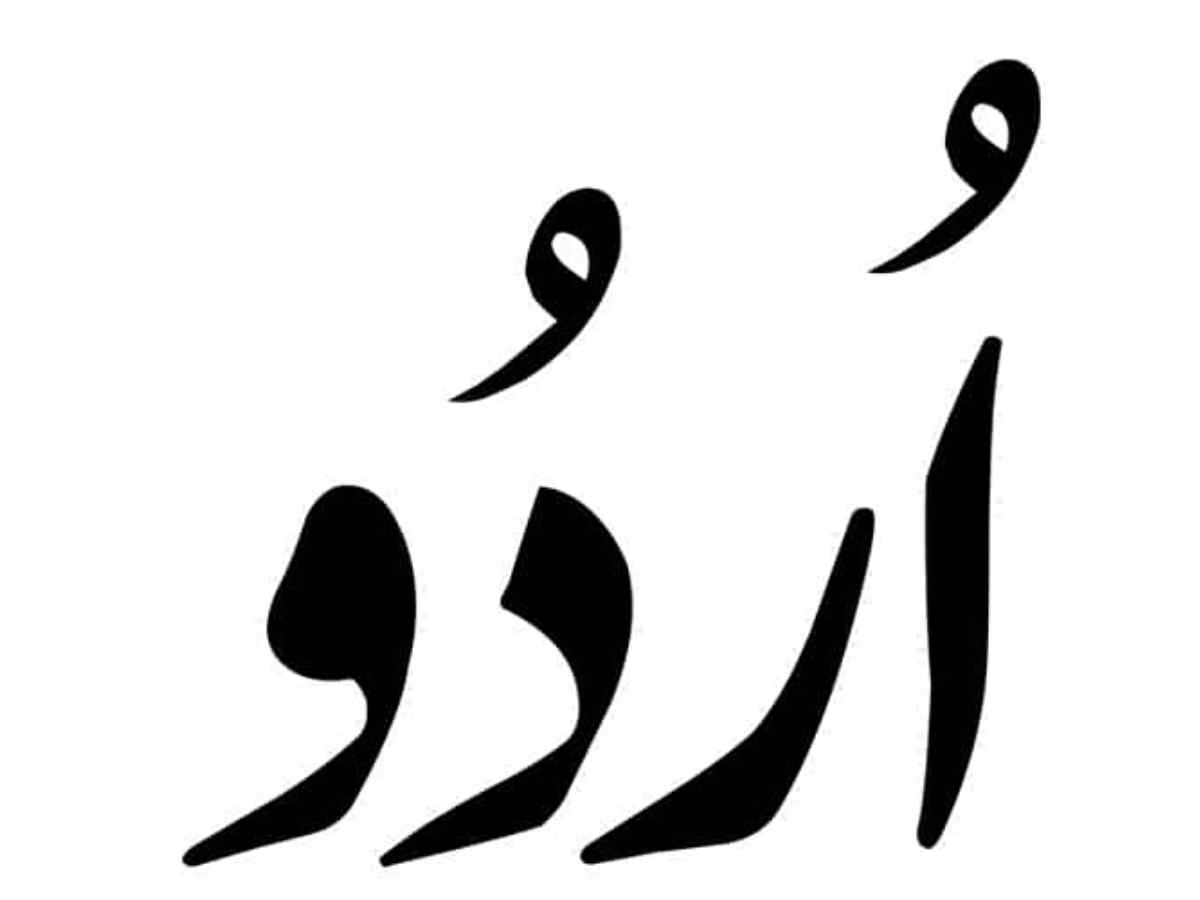
By FIROZ BAKHT AHMED
Bari aristocracy hei zabaan mein
Nawabi ka maza deti hei Urdu faqiri mein!
(The language is so rich in aristocratic ethos
To a pauper it gives a king’s royalty all across! )
The fragrance, candour and timelessness of Urdu, basically an Indo-Aryan language was stamped at the two-day International Urdu Webinar by the NCPUL (National Council for the Promotion of Urdu Language) recently in New Delhi. It goes without saying that since time immemorial, Urdu had been the lingua franca of Sindh, Gujarat, Madhya Pradesh, undivided Bengal, Punjab, Doaba etc besides being the language of the heart and soul as emphasized by the Hindi litterateur cum Education Minister of India, Ramesh Pokhriyal Nishank at its inauguration.

Topic of two-day webinar
The topic of the two-day webinar was, “The role and responsibility of Urdu writers in the age of electronic and social media”. The two-day webinar of this international conference by the NCPUL (National Council for Promotion of Urdu Language) began with the inaugural address by Ramesh Pokhriyal Nishank, the Minister of Education of India on the first day, where he emphasized that Urdu is a language of not only composite culture, syncretism and interfaith bonds but also of humaneness of heart and soul. Added Nishank that this webinar has been conducted to celebrate the quintessential spirit of Urdu, its inclusive ethos and creative character.
Prof Shahid Akhtar, the Vice Chairman, NCPUL, said that around 35 eminent Urdu litterateurs plus thousands of connoisseurs of Urdu from all over the world had participated with very efficacious suggestions to promote the language of Urdu in these days of social media with smart phones where the information is just a touch away! Suggestions were also made on how to promote Urdu in these days of Covid-19. Frankly speaking, as also professed by many speakers, Urdu has become techno-savvy with the help of Urdu platforms like NCPUL that has actually been able to avail hundreds of books’ soft copies through an app.
Eminent Urdu professor, Zaman Azurdah said that the writers, poets and authors are the eyes of the entire social, religious and political system and they have a huge responsibility towards their connoisseurs and the lovers of the language and literature and hence, have to be very positive sans all negetivity. He also added that the most powerful source of information is the social and electronic media. Like the authors, poets and journalists of other languages, Urdu writers too are toeing the line of the internet and are connecting globally via smart phones and laptops.
Even before the advent of Muslims in India, the country was connected historically, culturally, politically, commercially via Arabic, Persian and Turkish, to the Middle East and other countries, including Iran, Sudan and Turkey. After Muslims settled in India, the conglomeration of the people of various cultures speaking a variety of languages, the birth of Rekhta, Hindavi and ultimately, Urdu, came into being.
Purpose of languages
This inter-mingling was also known as Lashkar. The purpose of all the Indian and international languages is to achieve the spirit of fraternal ambiance and ecumenism. Urdu is a beautiful language born out of the conglomeration of Hindu, Muslim and even English cultural background.
Opines Dr Humra Parveen of Department of Mass Communication, AMU that Urdu happens to be the language of the conglomerate tradition and culture of India that, after being acquired by the Khanqahs , educational institutions and the official world, also became th language of market During the times of Mohammed Shah and Quli Qutub Shah, it became the government’s language. At that time, it was in fact the most popular language. Owing to its poetic exuberance and an easy language to learn (which it is even today), Urdu replaced Persian.
The cultural and artistic tone and tenure of Urdu has been depicted generously in multifarious forms, including the Mushaira (poetic gathering), Marsiahkhwani (elegy) Ghazal (poetry recitation), Qawwali (chorus), Dastangoi (story telling), Chahar Bait (poetry competition) Mujra (ballet) etc besides other art forms, like drama.
The reason that Urdu got proliferated and promoted was owing to its secular character and a universal base in India and abroad. Today Urdu happens to be one of the most popular of all international languages. Not only that Urdu is a language of the subcontinent but it has become an important SAARC link language.
In India alone, as per the government records, more than 70 million people’s mother tongue is Urdu. However, an equal number of Urdu-knowing people are spread all over the nation. In the state of Kashmir, Urdu is the first language while in other states like — Uttar Pradesh, Delhi, Telangana, Andhra Pradesh, West Bengal — it has been recognized as the second language of the second language.
Nevertheless, there are some other areas where people have recorded Urdu to be their mother tongue, like — Bihar, Maharashtra, Karnanataka, Jharkhand and Rajasthan. So far as the linguistic link of Urdu is concerned, its family includes — Sanskrit, Persian, Arabic, Dravidian languages like — Telgue and Kannada.
Owing to its historicity, linguistic appeal, cultural multiplicity and literary taste, it doesn’t have any religion or religion. Connoisseurs of Urdu are found round the world in each nook and cranny. Besides, another salient feature of Urdu has been its linkage to the dialects. Lovers of Urdu who are also writers, especially from Punjab, Kashmir, Maharashtra, Telangana and Karnataka, have also glorified the language globally.
All languages are beautiful
All languages are beautiful and have their own charm and distinct persona. Urdu, in particular, is sweet and poetic and at the same time, very adaptable. If a language can be developed through a combination of seven languages, what can be more flexible and welcoming? Many foreigners have asked to hear Urdu, and when they have, their first impressions are: it is so soft and easy on the ears.
The family of Urdu languages include — Hind-Irani) Persian and Uzbek), Saami (Arabic, Turkish, Dravidian ()Telgue and Kannada), Germanic (English) and Hind-Aryan (Sanskrit). In fact the inner spirit of Urdu is Sanskrit, a relationship of mother and daughter indeed!
Another interesting aspect of Urdu is that it has incorporated in itself the idioms, clichés, phonetics and sounds and pronunciation. Indian languages like — Punjabi, Hindi, Marathi, Sindhi, Hindi, Gujarati, Pushto, Bhojpuri, Awadhi, Kashmiri, Telgue and Kannada — have all be the part and parcel of Urdu. Urdu has been connected to these since centuries.
Same is the case with many foreign languages, like — Arabic, Persian, Turkish, English, Uzbek and Nepali that have gelled quite well with Urdu. It is assured that if a language has viable connects with the other languages, the result is a very pleasant one, basically owing to the intermingling. In this regard, it is pertinent to mention that Urdu is a window to the cultural heritage of Indian ambiance of harmonious bonding between one and all.
Urdu makes us introspect. Urdu is a language of composite culture and joins lacerated hearts! NCPUL has been promoting Urdu on a pan India basis by conducting seminars, workshops on calligraphy, graphic designing, e-books, Urdu media and other topics besides teaching of Urdu, Persian and Arabic to their connoisseurs from all cross sections of society besides bringing out of Urdu magazines like, “Urdu Dunia” (monthly), “Bachchon ki Dunia” (children’s monthly) “Khawatin ki Dunia” (ladies’ monthly magazine) and “Fikr-o-Tehqeeq (research-based tri-monthly).
(Firoz Bakht Ahmed is the Chancellor of Maulana Azad National Urdu University and grandnephew, Bharat Ratna Maulana Azad)
A-202 Adeeba Market and Apartments, near Rehmani Masjid, Main Road, Zakir Nagar, New Delhi 110 025, Email: firozbakhtahmed08@gmail.com

